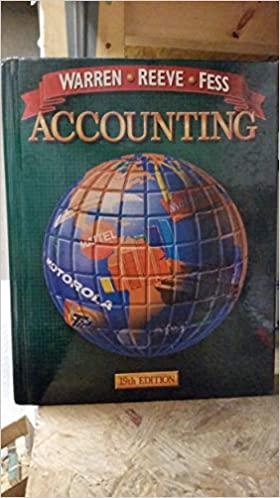Compute and Interpret Coverage, Liquidity and Solvency Ratios Selected balance sheet and income statement information from CVS Health Corp. for 2014 through 2016 follows ($
Compute and Interpret Coverage, Liquidity and Solvency Ratios
Selected balance sheet and income statement information from CVS Health Corp. for 2014 through 2016 follows ($ millions).
| Total Current Assets | Total Current Liabilities | EBIT (Operating income) | Interest Expense, Gross | Total Liabilities | Equity | |
|---|---|---|---|---|---|---|
| 2016 | $33,930 | $26,250 | $10,504 | $1,058 | $57,628 | $39,722 |
| 2015 | 32,046 | 23,169 | 9,620 | 838 | 55,234 | 40,091 |
| 2014 | 28,871 | 19,027 | 8,965 | 600 | 36,224 | 40,851 |
a. Compute times interest earned ratio for each year and discuss any trends for each. Round answers to one decimal place.
| Year | TIE Ratio |
|---|---|
| 2016 | Answer |
| 2015 | Answer |
| 2014 | Answer |
Based on your computations above, select the most appropriate answer.
Times interest earned has steadily increased since 2014.
Times interest earned has steadily decreased since 2014.
Times interest earned has remained the same since 2014.
Times interest earned increased in 2015 but then decreased in 2016.
b. Compute the current ratio for each year and discuss any trend in liquidity. Round answers to one decimal place.
| Year | Current Ratio |
|---|---|
| 2016 | Answer |
| 2015 | Answer |
| 2014 | Answer |
Do you believe the company is sufficiently liquid? Explain.
CVSs current ratio has increased over the past three years and is greater than 1, indicating CVS is liquid.
CVSs current ratio has decreased over the past three years and it is currently less than 1 indicating CVS is not liquid.
CVSs current ratio has increased over the past three years, however, it remains less than 1 indicating CVS is not liquid.
CVSs current ratio has decreased over the past three years, however, it is greater than 1 indicating CVS is liquid.
c. Compute the total liabilities-to-equity ratio for each year and discuss any trends for each.
Round answers to one decimal place.
| Year | Liabilities to Equity |
|---|---|
| 2016 | Answer |
| 2015 | Answer |
| 2014 | Answer |
Based on your computations above, select the most appropriate answer.
CVS's liabilities to equity ratio has increased since 2014, however, the ratio is relatively low, concluding CVS is solvent.
CVS's liabilities to equity ratio has decreased since 2014, remaining relatively low, concluding CVS is solvent.
CVS's liabilities to equity ratio has increased since 2014, and is relatively high, concluding CVS is insolvent.
CVS's liabilities to equity ratio has decreased since 2014, remaining relatively low, concluding CVS is insolvent.
d. What is your overall assessment of the companys credit risk from the analyses in (a), (b), and (c)?
CVS is a low credit risk as it has a low level of debt, is liquid and can easily meet its interest expenses.
CVS is a low credit risk as its liabilities to equity ratio, current ratio, and times interest earned ratio have all decreased since 2014.
CVS is a medium to high credit risk as its level of debt has increased and its current ratio and times interest ratio have decreased.
CVS is a medium to high credit risk as its liabilities to equity ratio, current ratio, and times interest earned ratio have all increased since 2014.
Step by Step Solution
There are 3 Steps involved in it
Step: 1

See step-by-step solutions with expert insights and AI powered tools for academic success
Step: 2

Step: 3

Ace Your Homework with AI
Get the answers you need in no time with our AI-driven, step-by-step assistance
Get Started


